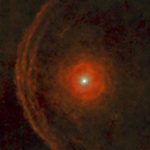Key Takeaway:
- A theoretical model (Gödel’s) proposed that the universe could rotate, challenging the idea of general relativity being complete.
- This model suggested the possibility of time travel into the past, which violates causality and creates paradoxes.
- In a rotating universe, observers would see themselves at the center of rotation, light would travel in strange paths, and movement could result in traveling back in time.
- Luckily, there’s no evidence we live in a rotating universe based on observations of distant galaxies and the cosmic microwave background.
- Gödel’s work highlights that general relativity might not be the whole picture, leaving open the possibility of time travel under exotic physics conditions.
Planets rotate, as we all know, but what about the universe as a whole? No, it doesn’t seem like the universe rotates; if it did, it might be able to travel back in time.
Although people throughout antiquity had argued that the heavens rotate around the world, in 1949, mathematician Kurt Gödel was the first to provide a modern formulation of a rotating universe. In order to pay tribute to his friend and Princeton neighbor, Albert Einstein, he did so using terms from the general relativity theory.
But this process of academic “honoring” went in a different direction than you might suspect, because Gödel used the example of a rotating universe to show that general relativity was incomplete.
Gödel’s model of a rotating universe was rather artificial. Besides the rotation, his universe contained only one ingredient: a negative cosmological constant that resisted the centrifugal force of that rotation to keep the universe static.
But the artificial nature of that universe didn’t bother Gödel. Rather, the central idea of his argument was that the existence of a rotating universe was made possible by general relativity. And Gödel used his rotating universe to show that general relativity allowed for time travel into the past, which should be forbidden.
Taking the universe out for a spin
It would be extremely strange to live in a rotating universe. For one, all observers would consider themselves the center of rotation. This implies that you could see the universe spinning around you if you parked somewhere and made sure you were still. However, the universe would continue to center around your new location even if you picked up and relocated to a different location, such as a distant galaxy.
It is very difficult to picture this, but it is not all that different from the notion that all observers in an expanding universe perceive themselves as the center of expansion.
The farther you go from any one observer, the greater the rate of rotation. And this isn’t merely a rotation of stuff but a rotation of space-time itself. This implies that light travels through some strange places because it is always forced to follow the curvature of space-time. When a light beam is swept up by space-time’s rotation, it will curve away from the observer. When the rotation becomes high, the light will eventually turn around and encounter the observer once more.
This means there’s a limit to how far you can see in a rotating universe, and beyond that, all you’ll observe is duplicate images of your own past self.
This strange behavior doesn’t apply only to light. You would become entangled in the rotation if you were to launch yourself through a rotating universe in a rocket. And your movement would double back on itself as a result of that rotation. When you returned to your starting point, however, you would find yourself arriving before you had left.
In a manner of speaking, a rotating universe would be capable of rotating your future into your own past, allowing you to travel back in time.
Sitting still
This was Gödel’s major objection to general relativity. That theory, being our ultimate understanding of space and time, should not allow for backward time travel, because time travel into the past violates our notions of causality and introduces all sorts of nasty time-travel paradoxes. Time travel was not naturally possible due to relativity, which indicated to Gödel that Einstein’s theory was not fully developed.
Fortunately, there are no indications that the universe is spinning around us. If the cosmos were rotating, then light coming from opposite directions of the sky would be redshifted in one direction and have an equivalent amount of blueshifting in the other. This test has been used by astronomers to examine surveys of far-off galaxies and even the cosmic microwave background, which is light from a time when the universe was only 380,000 years old. Based on the results of these tests, we can conclude that the rotation rate of the universe, if it is occurring, is less than 10^-17 degrees per century.
But Gödel’s objection still stands. Since 1949, physicists have concocted other ways for general relativity to allow for backward time travel, wormholes, faster-than-light-speed “warp drive” (known as Alcubierre drive), and special paths around infinitely long cylinders. However, all those tricks rely on some kind of exotic physics—like matter with negative mass—that challenges our understanding of how the universe works.
But Gödel’s rotating universe is simply a matter of observational test, not a fundamental break with known physics. We could have found ourselves in a rotating universe just as easily as we find ourselves in an expanding one. Nothing in our understanding of physics prevents the existence of this kind of universe, and similarly, nothing in our understanding of physics prevents backward time travel.
Maybe Gödel is correct, and there is still more for us to discover about the cosmos.

